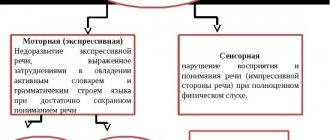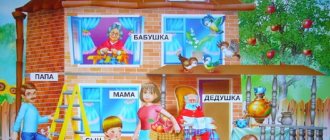- Game “The horned goat is coming...”
Goal: Formation of imitative movements (using words with simple structure), development of general motor skills.
Equipment: bibabo doll (goat)
Progress of the game: Children accompany the words of the speech therapist with the appropriate movement:
Speech therapist: A horned goat is coming,
There's a butted goat coming
For the little guys.
Top-top with your feet (Children repeat: “Top-top” and stamp their feet.)
Eyes clap-clap. (Children, raising their hands at eye level, clench and unclench their fists, repeat the end of the phrase.)
Speech therapist: Who doesn’t eat porridge?
Who doesn’t drink milk - (Children make appropriate movements.)
Gore, Gore, gore! (Children accompany the words of the speech therapist with appropriate movements.)
- Game "Guess the musical instrument"
Goal: Education of auditory attention.
Equipment: children's musical instruments (drum, pipe, xylophone, accordion...).
Progress of the game: First, the child must determine which instrument sounded; then indicate the direction of the sound of the sounding instrument or toy; reproduce the rhythm of the sound.
The speech therapist first introduces the child to the sound of, for example, an accordion or a drum. The child is blindfolded or asked to turn away, after which the speech therapist plays one of these instruments, and then invites the child to find the instrument he played and play it too.
3. Game. "Find toys."
Goal: Development of spoken speech using onomatopoeia.
Equipment: toys (dog, cow, cat).
Progress of the game: the speech therapist hides toys (dog, cow, cat) in the office or near him, the child looks for toys, finds them and when the speech therapist asks “Who is this?”, says: “Am-am, mu-mu, meow-meow.” .
4. Game "My Family"
Purpose of the game: development of perceived and independent speech, expansion of the dictionary on the lexical topic “Family”.
Equipment: pictures on the theme “family”.
Progress of the game: The speech therapist, having seated a small group of children or one child, shows one by one the family members depicted in the picture, names them clearly, clearly and concisely:
“This is dad, mom, grandpa, grandma, Tata, Vova”
To check understanding and assimilation, the speech therapist invites children to show their father, mother, grandmother, etc. in the picture.
If there is a group of children at the lesson, then it is better to ask one child to show dad, another to show mom, etc., but with the expectation that each child names all the people depicted in the picture.
The speech therapist points to individual family members in the picture and asks, “Who is this?” The child answers: “This is mom, this is dad,” etc.
5. Game “Find the odd one out”
Goal: development of logical thinking, repetition and expansion of vocabulary on covered lexical topics.
Equipment: pictures depicting objects on the lexical topics covered (vegetables, fruits, animals, birds, insects, dishes, etc.)
Progress of the game: the speech therapist lays out in front of the child a number of pictures of one forest theme and one picture from another (for example: lemon, apple, butterfly, pear), clearly names them and asks to find the extra picture.
Thinking games
These games are offered to the child according to the principle “from simple to complex .
First, he is asked to compare objects by color and size, and then by more significant characteristics.
- Arrange the pictures according to some criteria: what we eat, what we wear, etc.
- Put together one picture from the cut pieces , first from two, then from 3-4. A complication is to offer pictures in which the image is on both sides.
- Guess what is drawn in the picture based on its part.
- “Mailbox” - lower the figures into the box, selecting the desired hole that suits the shape.
- “Who needs what” - match the tools of action to the actions depicted on different cards (a net for a girl catching a butterfly, a comb for a shaggy girl, a needle for a boy with a hole in his shirt).
Games for sensory development (color, size, shape)
Children with motor alalia experience difficulties with spatial orientation, as well as in determining the color, shape and size of objects.
Their cognitive interest is also not very pronounced.
Games will help solve these problems:
- You need to choose from balls of the same size only red ones, only white ones, etc.
- Invite your child to bring the same number of cubes as matryoshka dolls;
- “Pick a flower” - arrange flowers of the same color in vases (all figures are made of paper);
- “Hide the ball in your palms” - offer to hide first a small, then a large ball in your palm, whether it works or not;
- “On the contrary” - in some pictures there are large objects, and in others the same objects, only small in size. The presenter says, holding up the picture: “I have a big pyramid...”. The child looks for the same one and answers: “I have a small one,” etc.
- Lotto for fixing colors with images of circles of different colors.
These games are given as an example to understand the principle of selection; in fact, there are a huge number of them.
If the child is still small, you need to carefully select motivation, why he needs to choose balls, pictures, etc. Offer to help a bunny, doll or bear, help them out - this will make it much more interesting for the baby to play and practice.
Card index of games for speech development for the correction of motor allalia
Ekaterina Abdullaeva
Card index of games for speech development for the correction of motor allalia
«CARD OF GAMES FOR SPEECH DEVELOPMENT FOR CORRECTION OF MOTOR ALALIA»
The outstanding linguist A. N. Gvozdev wrote: “The sentence plays a separate role the development of children’s speech ...it is the basic unit of speech as an instrument of thinking and generalization. Mastering one’s native language mainly occurs in the form of mastering sentences of various types.”
For various forms of alalia, it is recommended that children learn to read and write at a relatively early age, since writing and reading allow them to better consolidate the learned material, as well as control oral speech. The key to the success of correctional work for alalia is its early intervention (from 3-4 years of age).
beginning, complex nature, systemic impact on all components
of speech , the formation of speech processes in unity with the development of mental functions . Corrective work to overcome alalia is aimed at developing speech in its complete absence or pronounced deficit, while maintaining hearing and intelligence.
When starting work, the speech therapist builds it on the basis of what the child has already achieved. With this speech pathology speech , active vocabulary, pronunciation of individual sounds or entire sound groups suffer, but speech practically does not suffer.
A prerequisite for productive work is repeated repetition of the same speech material. Here we bring to your attention a card index we have developed for speech development for the correction of motor alalia in order to make classes interesting for children.
The goal is to teach conscious analysis of speech , develop phonemic perception and understanding of speech .
Correctional and developmental work is aimed primarily at creating mechanisms of speech activity and is solved through a number of set tasks.
Tasks:
• form communicative intentions;
• mastery of the mechanisms of grammar, the principles of its operation (there is a selection of lexical and grammatical means)
.
Equipment and materials:
Card index of didactic games:
1. Didactic material on constructing a two-part phrase.
2. Didactic material on practicing singular and plural numbers.
3. Didactic material on composing a sentence of three words: subject, predicate and direct addition.
4. Didactic material on training the ability to retell short stories close to the text.
5. Games and exercises for speech development :
• games for the formation of lexical and grammatical categories and word formation skills in children
• games for lexical development in the process of familiarization with natural phenomena
• games to activate associative semantic connections between words
• games and exercises to familiarize preschoolers with linguistic phenomena. Familiarization with synonyms.
• games for the formation of emotional and evaluative vocabulary.
Our card index contains lexical and didactic material that facilitates an interesting and repeated exercise for children in constructing a simple two-part phrase (an object and its action)
and its use in
speech .
1. In the first didactic set, the names of six toys previously learned by the child are taken: cat, bear, rooster, hare, pig, doll. At the same time, children can call them with words that are simpler in structure: cat - kitty, bear - Misha, pig - piggy, rooster - petya, hare - hare, doll - lalya. At this stage, the sound pronunciation quality of words is not so important. It is necessary to repeat them many times, use them in different situations, which will contribute to understanding, clarification, expansion, and also improvement of the dictionary, i.e. gradual
improving its sound-syllable structure. At this stage of work on the phrase, the seven most easily understood and frequently used verbs for children are given, denoting the following actions: goes, runs, sits, sleeps, rides, swims, flies. Each verb is first practiced with the indicated six toys: Lala goes, Misha goes, piggy the bunny is coming, the kitty is coming. The speech therapist or teacher says: “the bear is coming.”
and with a straight index finger points to the drawing called.
Not only the pronunciation of phrases is formed, but also their understanding. When all the pictures are named , the adult gives the instruction “Misha is coming.
Show me where .
If the child finds it difficult to show, the adult helps by showing the named picture . According to the instructions “Misha is coming.
Cover the picture. ” The child places a chip on it
(either himself or with the help of the teacher)
.
When all the pictures , the instructions change: “Misha is coming.
Open the picture .
" The child himself or with the help of a teacher opens all the pictures . The child must listen and understand the adult’s instructions. After the verb “goes”,
“runs”
is worked out in the same order .
When practicing these two verbs, the sequence of arrangement of pictures on the sheet is the same , so that at the initial stage it is easier for the child to navigate. Then comes the differentiation of the verbs “goes - runs”
.
the pictures are already swapped . The actions given are “walking”
, on the right -
“running”
.
Then on the left - “runs”
, on the right -
“walks”
.
Children should not get used to a certain arrangement of material, mechanically show pictures and repeat a phrase . It is necessary to learn to listen attentively to the speech of adults, understand it, navigate and find the right picture .
Subsequently, when new material is presented, the arrangement of objects changes places. Changing the location of the characters helps to develop concentration, stability, switching attention, and improve visual perception. Each new verb that is practiced is differentiated from all the verbs that have been passed. Constant work on differentiating verbs helps the child understand their meaning. After practicing all the verbs and their differentiation, various actions performed by one character are given on one sheet. If previously the child was guided by the first word - an object, and then named the action - one for all objects, now he must focus on the second word - a verb denoting various actions. The number of lessons to practice one action, or the differentiation of two actions, is different for each child, depending on how he learns the material. At first it takes longer, but then absorption usually goes faster. However, you should not take more than one activity per lesson and no more than two activities for differentiation. Performing several actions by one character is given in one lesson, by another in the next, etc. When repeating the material covered, the child can be asked additional questions that force him to listen, look and think better. For example: “Tell (show me) who is sitting on the rug? Who is sitting on the stump? Who is sailing in the boat?”, etc. This contributes not only to the development of speech hearing speech understanding , but also prepares the child for dialogue.
2. When working with the second set of didactic material, I would like to teach the child to hear and distinguish between singular and plural endings of nouns ending in “-ы –и”
or
“-a - ya”
and verbs with the ending
“-ut -yut”
or
“-at -yat”
and use them in
speech when composing sentences from two words: subjects and predicate.
3. In the third didactic set, we teach the child to compose a sentence of three words: subject, predicate and direct addition. The speech therapist says all the sentences, the child finds the corresponding pictures and covers them with chips ( “Tell me - what is the girl drawing?”
). The child speaks simple, common three-word sentences conjugately, reflectedly, or independently. Using this scheme, you can work out all the proposals.
4. The fourth didactic set is designed to teach children to understand the content of texts, to train the ability to retell short stories close to the text. Each story is given on a separate card and is accompanied by questions about the content of the text.
5. The fifth didactic set is intended for teaching children speech development : games for the formation of lexical and grammatical categories and word formation skills in children; games for lexical development in the process of familiarization with natural phenomena; games to activate associative semantic connections between words; games and exercises to familiarize preschoolers with linguistic phenomena. Familiarization with synonyms; games for the formation of emotional and evaluative vocabulary.
In conclusion, I would like to repeat: “What do you need to remember when carrying out correctional work ?”
.
Do not overdo repetition, reflected speech. The child must actively assimilate speech through objective-practical activities and the accumulation of sensory experience. Repeat in different situations, performing different actions, meaningful repetition.
If children are speechless, then start with onomatopoeic interjections. If there are full-fledged words, we immediately move to a higher level. But first, we replace polysyllabic ones with words of a simpler syllabic structure (not a cow, but a bull, not a dog, but a dog)
.
Issues of correcting sound pronunciation are relegated to the background. First, start the language mechanism.
The basis of speech is reliance on predication. DO NOT sit for a long time at the nomination stage, do not memorize names, note functions, purpose, actions with objects.
Propositionation is the construction of a judgment about a specific object, action (what one sees, feels, does)
.
Coordination of speech and movement , rhyming with movements, plus intonation (if he does not speak, then intonation is already speech)
. Gestures and facial expressions are non-verbal sentences. This is kinetic speech. While there are no verbal opportunities, you can use it. Show verbs through pantomime. Tell a fairy tale using facial expressions, gestures, and interjections. The teacher speaks loudly for the child. This is considered as phrasal speech.
Eliminate linguistic formalism - do not memorize concepts. Everything we give must be understood. Effectively give in opposition (big - small, quiet - loud)
. Contrast and opposition are well understood and learned faster.
All work must be positive for the child. The emotional mood is very important. Start with visual perception, fixate the object and trace it with your eyes, then connect other sensations.
List of sources used
1. ZhukovaN. S., E. M. Mastyukova, T. B. Filicheva: Overcoming speech development delays in preschool children . – M., 1973.
2. Zhukova N. S. Formation of oral speech : Educational and methodological manual. - M: Sots. - watered magazine, 1994.
3. Kuzmina N. I., Rozhdestvenskaya V. I. Speech education in children with motor alalia . - M., 1977.
4. Speech therapy: Textbook for pedagogical students. institutes specializing in “Defectology”
/ L. S. Volkova, R. I. Lalaeva, E. M. Mastyukova, etc.; Ed. L. S. Volkova. - M.: Education, 1989.
5. Author: Novikova - Ivantsova T. N. Title: From word to phrase. Publisher: M.: 2006









